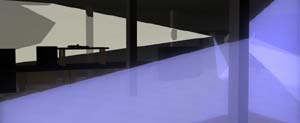
A rave party is an international youth phenomenon, which provides an interesting paradigm for study of cross cultural behavior. The embrace of technology in techno music, and the "altered state" sought after by promoters, DJ's and ravers create a phenomenon well suited to a virtual reality environment.
The goal of this piece is to create and study the effects of a global rave party in a real-time, collaborative, virtual environment.
This application
allows multiple users in diverse physical locations to connect in the shared
space of the VR Rave. Users can dance by themselves, or with others in
real time. They can control the music or "DJ" which in turn controls light
systems and other optical effects. Each raver is represented by an avatar, allowing
the communication of gesture and dance movements.
 |
Early rendering of the warehouse model. User is allowed full navigation including the ability to "DJ" and control the music. |
The ability of the user to control the music, and their environment creates
a customized experience unique to the participants. User's interaction becomes
a fundamental part of the piece. The synergy of remote multiple participants
defines the art work as a whole. This cross cultural exploration of behavior
opens broad possibilities in interactive art, sociology, and the study of behavior.
| Geomety based lighting systems allow for multiple, real-time audio controlled light systems. |  |
 |
The minimum hardware required for this project is one Idesk or CAVE for a single user experience. We encourage the the use of multiple VR systems to showcase the collaborative aspects of the piece. It is possible to connect to remote VR sites such as The Electronic Visualization Lab (EVL), ARS Electronica, or many other research institutions world wide which have Idesk, or CAVE technology. We would like to demonstrate this piece with at least three users, one being local to Vienna, one at EVL in Chicago, and one possibly at ARS. The hardware used in this project is completely functional, and commercially available. Specifically a fully functional CAVE and Idesk is installed in the ARS Electronica Center in Linz, Austria. The software has been partially written, and by the end of December will be shown at the final MFA critique in the Electronic Visualization Lab at the University of Illinois at Chicago. The first public release version of the software will be in May of 1999. The
overall cost depends greatly on the VR system used for the installation.
Assuming one location of this piece is in Vienna, then the cost can be
offset by renting hardware from Pyramid
Systems, and SGI, or borrowing from
ARS Electronica. Since this software
runs on a standard VR system, show time could be shared between projects
using the same resources. Other costs include the shipping
of this equipment, and 3rd party companies who may be helpful would be Silicon Graphics, Pyramid Systems, and The Electronic Visualization Laboratory. |
For
more information, contact:
Tom
Frisch tomk@evl.uic.edu
Benjamin Goldstein benjamin@evl.uic.ed
Carlos Orrego
corrego@eecs.uic.edu